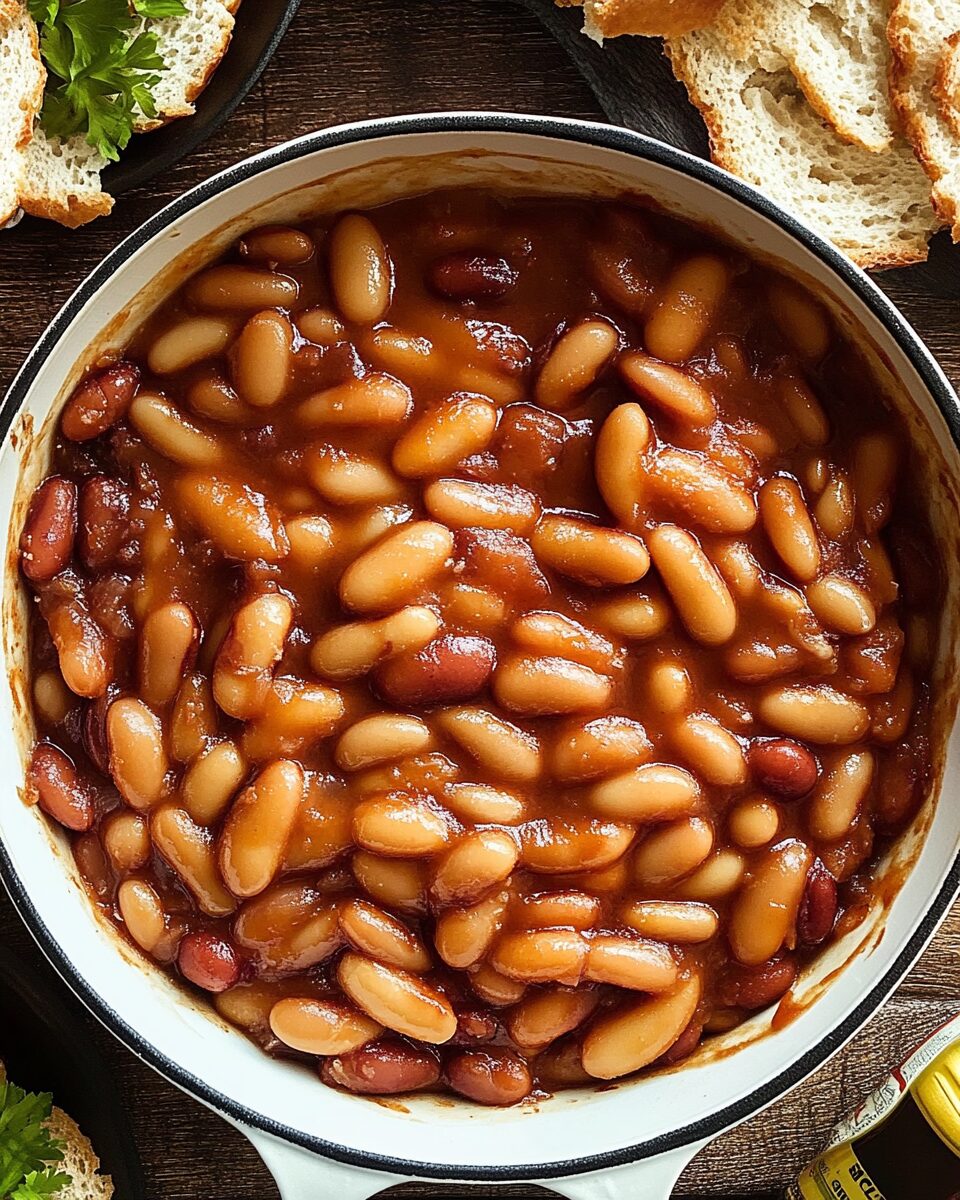There’s something undeniably heartwarming about a pot of slow-cooked New England Baked Beans. Rich in flavor from molasses and salt pork, every spoonful offers a perfect balance of sweetness and savory depth that truly captures the spirit of traditional American comfort food.
This dish is not only a wonderful side for barbecues and hearty dinners but can easily take center stage at any cozy gathering. Whether you serve it alongside cornbread or grilled meats, its old-fashioned charm and robust flavor will have everyone asking for seconds.
Full Recipe:
-
1 pound dried navy beans
-
8 cups water, divided
-
1/2 pound salt pork, diced
-
1 large onion, finely chopped
-
1/2 cup molasses
-
1/4 cup brown sugar
-
1 tablespoon Dijon mustard
-
1 teaspoon salt
-
1/2 teaspoon black pepper
-
1/4 teaspoon ground cloves
-
2 cups reserved bean cooking water
Directions:
-
Rinse and sort the navy beans, then place them in a large pot with 6 cups of water. Bring to a boil, then remove from heat, cover, and let soak for 1 hour.
-
Drain and rinse the beans, then refill the pot with 6 cups of fresh water. Bring to a boil again, reduce heat, and simmer for 45 minutes until beans are just tender.
-
Preheat the oven to 300°F (150°C).
-
In a large Dutch oven, layer half the diced salt pork on the bottom, followed by half the chopped onion.
-
Add the beans on top, then the remaining salt pork and onion.
-
In a bowl, whisk together molasses, brown sugar, mustard, salt, pepper, and cloves with 2 cups of the reserved bean cooking water.
-
Pour the molasses mixture over the beans.
-
Cover and bake for 6–7 hours, checking occasionally and adding more water if needed to keep beans just covered.
-
Uncover for the last 30 minutes to thicken the sauce.
Prep Time: 15 minutes | Cooking Time: 7 hours | Total Time: 7 hours 15 minutes
Kcal: 320 kcal | Servings: 8 servings
The History of New England Baked Beans
New England Baked Beans are much more than a simple comfort food — they are a cultural symbol of early American culinary traditions. Their origins can be traced back to Native American tribes like the Narragansett and Wampanoag, who first cooked beans with maple syrup and bear fat in earthen pits. When Puritan settlers arrived in the early 17th century, they adapted the method, replacing native sweeteners with molasses, a product abundantly available due to the transatlantic trade. Over time, the recipe evolved but always retained its slow-cooked, hearty nature. Boston, in particular, became so associated with baked beans that it earned the nickname “Beantown,” a legacy that still endures today.
What Makes New England Baked Beans Unique
Unlike other versions of baked beans found throughout the United States and the world, New England Baked Beans are characterized by the use of molasses and salt pork. Molasses adds a deep, rich sweetness, balancing the savory, salty bite of pork fat that melts into the beans as they cook. Traditional recipes call for navy beans, known for their small size and creamy texture after long cooking. What truly sets this dish apart is the slow-baking method, often done over six to eight hours in a low oven, which allows the flavors to meld into a dense, slightly sticky, yet incredibly flavorful dish.
The Role of Molasses in the Recipe
Molasses is a critical component that gives New England Baked Beans their signature taste and dark color. During colonial times, molasses was a common pantry staple, imported from the Caribbean as part of the rum trade. Its use in cooking was widespread, but it found an especially important place in baked beans. Light or dark molasses may be used depending on the cook’s preference, with darker molasses providing a deeper, more pronounced caramel flavor. The thick syrup caramelizes during the long bake, enriching the beans with complex, bittersweet notes that complement the smoky salt pork perfectly.
The Importance of Slow Cooking
True New England Baked Beans are not rushed. Traditionalists insist on a slow and low baking process to achieve the desired thick consistency and flavor depth. Historically, families would prepare the dish on Saturday and leave it in the brick oven overnight to be enjoyed after Sunday church services. This method allows the beans to soften to perfection while absorbing the flavors of the molasses, pork, and spices. While modern conveniences like slow cookers and Instant Pots can be used today, the oven-baked method continues to deliver the richest and most authentic results.
Cultural Significance of Baked Beans in New England
The cultural heritage of New England Baked Beans cannot be overstated. In colonial New England, the Sabbath was strictly observed, which meant no cooking was allowed on Sundays. Baked beans, prepared in advance, became the perfect meal to serve on the day of rest. Paired with brown bread or hearty meats, it provided nourishment and comfort without breaking religious codes. Over time, baked beans became a staple at gatherings, celebrations, and everyday meals, symbolizing thrift, resourcefulness, and the warmth of home cooking.
Modern Twists on a Classic Recipe
While many purists insist on sticking closely to the original formula, New England Baked Beans have inspired numerous variations. Some cooks substitute bacon for salt pork, adding a smoky twist. Others might mix in additional spices like smoked paprika, bay leaves, or even a splash of bourbon for complexity. Vegetarian versions swap out the pork for olive oil and enhance the depth of flavor with extra spices and vegetable broth. Regardless of the variations, the essence of the dish — sweet, savory, slow-cooked beans — remains unmistakably tied to its New England roots.
Perfect Pairings for New England Baked Beans
New England Baked Beans shine as both a side dish and a main attraction. Traditionally, they are served with brown bread, a dense, molasses-sweetened loaf often steamed rather than baked. Their robust flavor also pairs beautifully with roasted or grilled meats like ham, pork ribs, or even chicken. In the summertime, baked beans often accompany barbecue spreads, offering a sweet counterpoint to smoky, tangy meats. In colder months, they become a hearty meal all on their own, especially when served with a fresh green salad or simple slaw to balance the richness.
Health Benefits of Traditional Baked Beans
Despite their indulgent flavor, New England Baked Beans offer several nutritional benefits. Navy beans are high in protein and fiber, aiding in digestion and helping to maintain steady blood sugar levels. They are also rich in essential minerals like magnesium, iron, and potassium. While the salt pork and molasses do add fats and sugars, when consumed in moderation, the dish can be part of a balanced diet. Additionally, homemade baked beans avoid the excessive sodium and preservatives often found in canned varieties, offering a more wholesome alternative.
Advertisement
Tips for Making the Best Baked Beans at Home
To achieve the most flavorful baked beans at home, a few tips can make all the difference. First, always soak dried beans properly to ensure even cooking. Using fresh, high-quality molasses rather than old, bitter stock will enhance the sweetness and complexity of the dish. Be patient during the baking process; resist the urge to raise the oven temperature to speed things along. Keeping the pot covered for most of the baking will prevent the beans from drying out, and uncovering it toward the end will help to thicken the sauce. Finally, tasting and adjusting seasoning before serving ensures a perfectly balanced dish every time.
Conclusion: Why New England Baked Beans Remain a Timeless Favorite
New England Baked Beans continue to hold a special place in the hearts and kitchens of American cooks for good reason. Rooted deeply in history and tradition, the dish captures the spirit of early American life — resourceful, hearty, and flavorful. Its reliance on simple, humble ingredients, transformed through time, patience, and skill, serves as a reminder that some of the most satisfying meals are also the simplest. Whether served at a family gathering, a holiday meal, or a casual Sunday supper, these slow-cooked beans offer a taste of history in every bite. Preserving and enjoying recipes like these keeps culinary traditions alive, connecting generations past and present around the dinner table.






